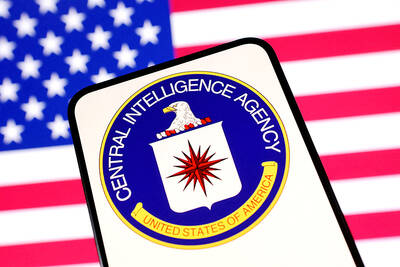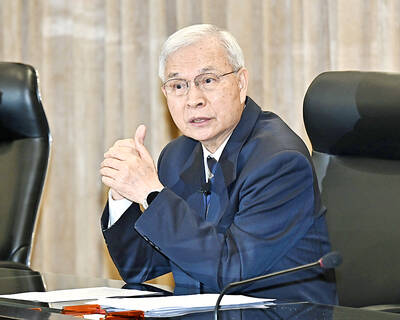It is getting closer to midnight.
On Thursday, the group of scientists who orchestrate the Doomsday Clock, a symbolic instrument informing the public when the Earth is facing imminent disaster, moved its minute hand from three to two-and-a-half minutes before the final hour.
It was the closest the clock had been to midnight since 1953, the year after the US and the Soviet Union conducted competing tests of the hydrogen bomb.

Photo: Reuters
Though scientists decide on the clock’s position, it is not a scientific instrument, or even a physical one. The movement of its symbolic hands is decided upon by the Science and Security Board of the Bulletin of the Atomic Scientists.
The organization introduced the clock on the cover of its June 1947 edition, placing it at seven minutes to midnight. Since then, it has moved closer to midnight and farther away, depending on the board’s conclusions.
Thursday’s announcement was made by Rachel Bronson, the executive director and publisher of the bulletin.
She was assisted by theoretical physicist Lawrence Krauss, climate scientist and meteorologist David Titley, and former US ambassador Thomas Pickering.
Bronson, in a post-announcement interview, explained why the board had included the 30-second mark in the measurement.
She said it was an attention-catching signal that was meant to acknowledge “what a dangerous moment we’re in, and how important it is for people to take note.”
“We’re so concerned about the rhetoric and the lack of respect for expertise that we moved it 30 seconds,” she said.
“Rather than create panic, we’re hoping that this drives action,” she said.
In an opinion piece for the New York Times, Titley and Krauss elaborated on their concerns, citing the increasing threats of nuclear weapons and climate change, as well as US President Donald Trump’s pledges to impede what they see as progress on both fronts, as reasons for moving the clock closer to midnight.
“Never before has the bulletin decided to advance the clock largely because of the statements of a single person,” they wrote. “But when that person is the new president of the United States, his words matter.”
In 1990, at the end of the Cold War, the clock was at 10 minutes to midnight. The next year, it was a full 17 minutes away, at 11:43.
However, over the next two decades the clock slowly ticked back. By 2015, the scientists were back in a state of unmitigated concern, with the clock at three minutes to midnight, the closest it had been since 1984.
“Unchecked climate change, global nuclear weapons modernizations, and outsized nuclear weapons arsenals pose extraordinary and undeniable threats to the continued existence of humanity,” the bulletin said.
“World leaders have failed to act with the speed or on the scale required to protect citizens from potential catastrophe,” it said.
“These failures of political leadership endanger every person on Earth,” it added.

The CIA has a message for Chinese government officials worried about their place in Chinese President Xi Jinping’s (習近平) government: Come work with us. The agency released two Mandarin-language videos on social media on Thursday inviting disgruntled officials to contact the CIA. The recruitment videos posted on YouTube and X racked up more than 5 million views combined in their first day. The outreach comes as CIA Director John Ratcliffe has vowed to boost the agency’s use of intelligence from human sources and its focus on China, which has recently targeted US officials with its own espionage operations. The videos are “aimed at

STEADFAST FRIEND: The bills encourage increased Taiwan-US engagement and address China’s distortion of UN Resolution 2758 to isolate Taiwan internationally The Presidential Office yesterday thanked the US House of Representatives for unanimously passing two Taiwan-related bills highlighting its solid support for Taiwan’s democracy and global participation, and for deepening bilateral relations. One of the bills, the Taiwan Assurance Implementation Act, requires the US Department of State to periodically review its guidelines for engagement with Taiwan, and report to the US Congress on the guidelines and plans to lift self-imposed limitations on US-Taiwan engagement. The other bill is the Taiwan International Solidarity Act, which clarifies that UN Resolution 2758 does not address the issue of the representation of Taiwan or its people in

US Indo-Pacific Commander Admiral Samuel Paparo on Friday expressed concern over the rate at which China is diversifying its military exercises, the Financial Times (FT) reported on Saturday. “The rates of change on the depth and breadth of their exercises is the one non-linear effect that I’ve seen in the last year that wakes me up at night or keeps me up at night,” Paparo was quoted by FT as saying while attending the annual Sedona Forum at the McCain Institute in Arizona. Paparo also expressed concern over the speed with which China was expanding its military. While the US

SHIFT: Taiwan’s better-than-expected first-quarter GDP and signs of weakness in the US have driven global capital back to emerging markets, the central bank head said The central bank yesterday blamed market speculation for the steep rise in the local currency, and urged exporters and financial institutions to stay calm and stop panic sell-offs to avoid hurting their own profitability. The nation’s top monetary policymaker said that it would step in, if necessary, to maintain order and stability in the foreign exchange market. The remarks came as the NT dollar yesterday closed up NT$0.919 to NT$30.145 against the US dollar in Taipei trading, after rising as high as NT$29.59 in intraday trading. The local currency has surged 5.85 percent against the greenback over the past two sessions, central